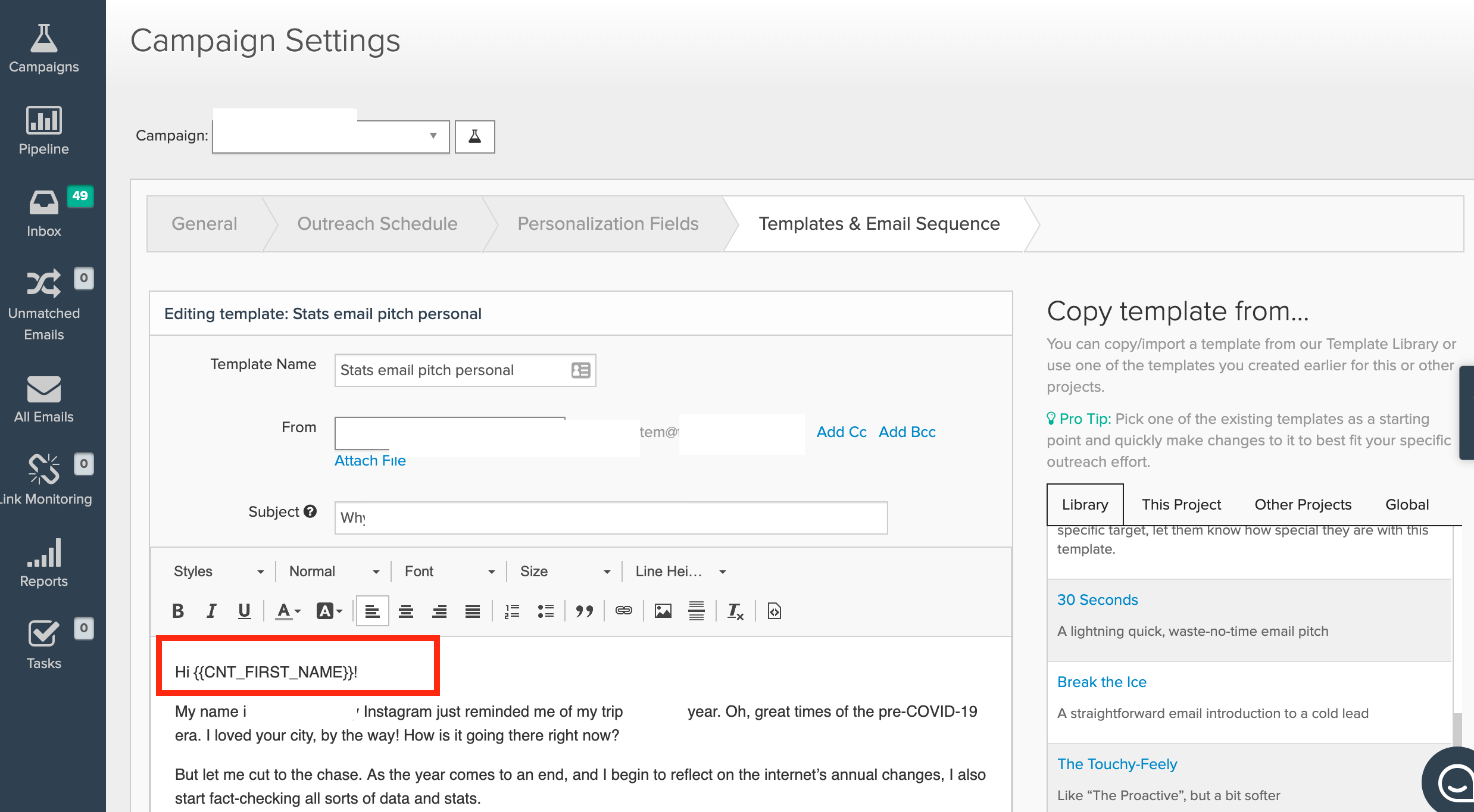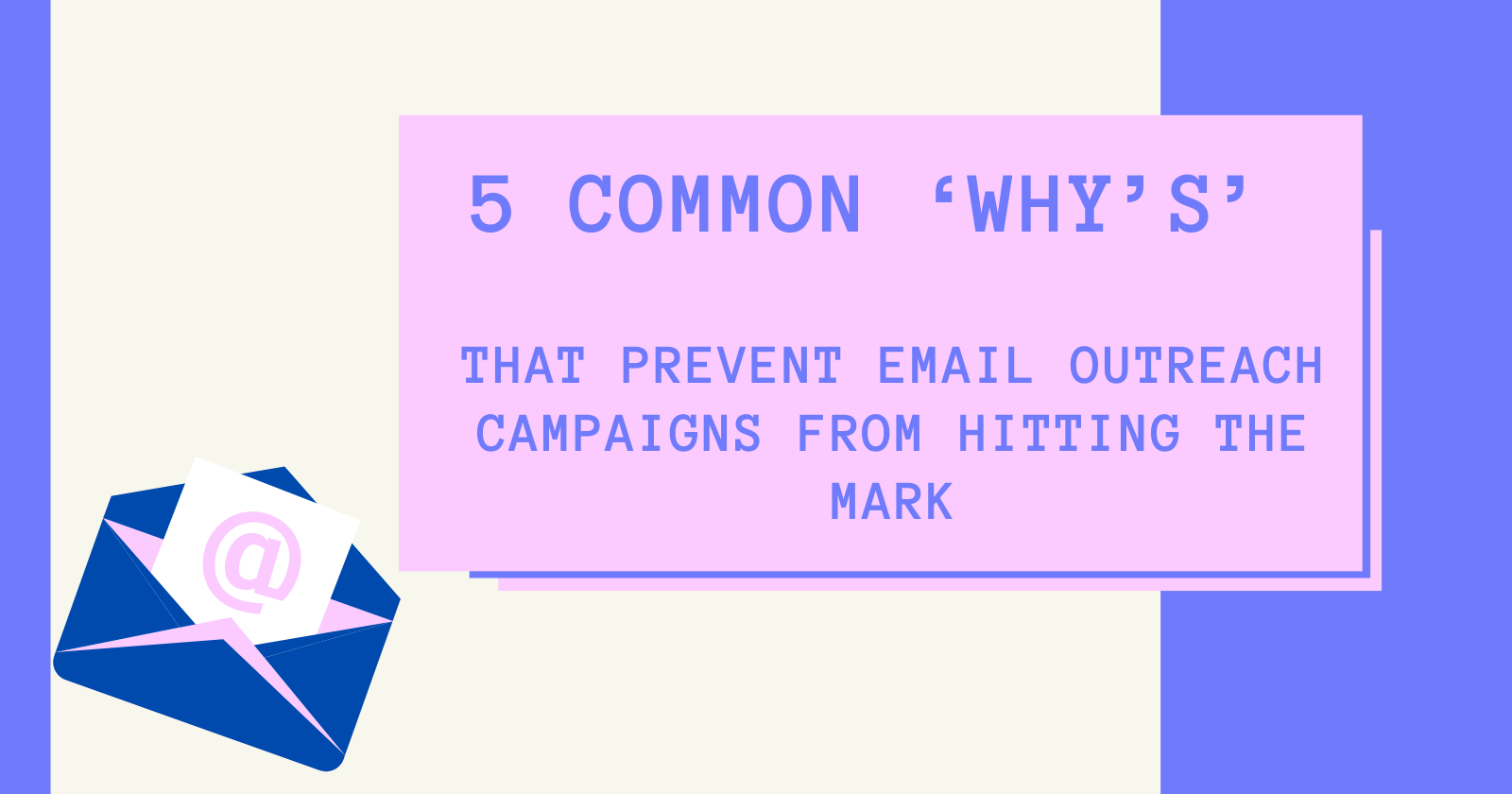Some say cold emails are always awkward.
You might think it’s a game of hit-or-miss and a matter of luck whether you’ll get a reply.
But I believe that every cold email has a big chance of being opened.
Everything boils down to how you approach it.
In this column, we’ll check out five common reasons email outreach fails.
But first, the baseline.
Personalization is an Email Basic, Not an Optimization
Too often, we see worn-out and overused email outreach templates like the one below.
Spend a bit of time researching the brand you’re trying to contact and invest that bare-bones effort into personalizing your emails.
For example, what’s wrong with this email?

It doesn’t include even a pinch of personalization.
The sender doesn’t address me by name and there isn’t even the slightest hint that they tried to research my company (or what we do), or the types of articles we usually post on our blog.
But a lack of personalization is not the only reason why many pitches end up in the trash folder.
1. Sending Emails to the Wrong People
You can tailor your message in the most creative and engaging way, but it won’t work if you send it to the wrong person.
And too often, good email outreach pitches end up in the wrong inboxes.
Your messages might not hit the mark simply because you’ve sent them to the people whose responsibilities do not include answering emails like yours.
I like this simple pattern for our link building campaigns:
- Search for a person who is responsible for SEO or link building in the company.
- If a business doesn’t have such a specialist, search for someone who’s responsible for creating content for this brand.
Of course, there’s still a chance you won’t find anyone that would fall under SEO/link-building profile.
In that case, really rethink why you are pursuing a partnership with such a business.
Keep looking for a brand with an active content strategy.
2. Following the Wrong Logic in Your Pitch
When I think about this reason, I always recollect an old Greek proverb about Epictetus, a famous philosopher and stoic.
After one of his speeches, the philosopher’s students began praising him for his ideas. Epictetus replied,
“If you are wasting time praising me, it means you hardly have anything valuable to share with me.”
I liken this to the nature of email outreach pitches known as ego-bait.
Basically, the sender praises the addressee, stuffs the email with compliments, and then asks the addressee for a favor.
I even see these pitches in my LinkedIn inbox from time to time:

The problem with ego-bait pitch emails is that they typically offer nothing truly valuable or meaningful in return for that favor they’re asking.
Think about a personalized offer that would definitely grab the addressee’s attention and win them over, instead.
For instance, you could check their blog for outdated content, find broken links, and suggest replacing them with something more relevant.
In my practice, we’ve done a successful outreach campaign by pitching an idea of replacing old data with fresh content.
3. Thinking That Adding a Name Is Proper Personalization
Many email outreach pitches all look the same, except for one thing: the name of the person they are addressing is different.
This is what happens when the sender applies the same template to every outreach email, changes the name, and calls it personalization.
In reality, you will hardly get someone’s attention with your pitch just by adding their name to it.
Besides, some tools do it automatically.
For instance, Pitchbox can extract all the contacts from the website automatically, and you can insert a person’s name with just one click.
That’s why you need to think about other, more meaningful personalizations.
Some of the same email outreach tools can help.
Using Pitchbox as our example: it allows you to insert so-called merge fields in the body of your email. You can improve your message by including the person’s geolocation or simply mentioning the latest blog article they’ve written.

4. Starting the Outreach With Email
Wait, aren’t we talking about email outreach campaigns?
What do you mean it’s not the best way to start communicating with a prospect?
It would be more productive to start the communication with a prospect via LinkedIn than to send numerous emails and follow-ups.
Email is more of a private domain, while LinkedIn is a social space suitable for networking.
People expect to hear from their network here.
Besides, on LinkedIn, you can check the profile and make sure you’re contacting the right person.
Speaking of LinkedIn, I should also add that it’s a great place for small talk, which inevitably takes place in the initial stages of building a relationship with a prospect.
On this platform, you can check the person’s activity, see the posts they liked, and read their comments.
As a result, you can use all that to establish a rapport and win the prospect over.
5. Failing to Offer Something in Return
The value of your professional relationships grows from mutual benefit.
It would be great if everyone was the Good Samaritan and offered stuff for free just because they want to help.
And maybe there are such people in your industry, but you can’t rely on that.
Same story for email outreach.
In our latest link building email outreach campaign, we found that about 50% of people asked about the benefit they would get if they gave us a link.
What can you offer that would be effective enough to persuade a prospect to give you that link?
If sharing ideas for updating outdated content and fixing broken links doesn’t fit your business profile, you could offer something else—Starbucks gift cards, for example, which has worked out quite well for us.
Another of my industry peers has shared their success with me in sending swag as a thank you for securing a link.
If you have media properties at your disposal — a newsletter or blog, for example — you could offer to feature them in your publication.
You can always use guest posts for that purpose, too.
Offer the prospect a link back to their website in your guest post.
Keep in mind though that if you set out to build hundreds of links to your site, you’ll have to write a good number of guest posts per month.
The choice is yours, but make sure you take your budget and resources into account.
Approach Email Outreach Like a Business Deal
In this article, we’ve discussed the five most common mistakes in email outreach campaigns.
From the lack of email personalization to sending your messages to the wrong people, focusing too much on praising someone, and not offering anything in return, these are the reasons your email outreach campaigns aren’t bringing the results you expect.
Perhaps the biggest reason of all that is underlying all of these mistakes is that you simply don’t treat email outreach as a business deal.
Outreach is just one step in developing a relationship with a client.
However, your outreach emails are your first impression.
Don’t miss out on the opportunity to make a good one, because it’s unlikely that you will get a second chance.
More Resources:
- How to Write Excellent Subject Lines for Your Outreach Emails
- 3 Alternative Link Building Tactics to Use Now
- Link Building for SEO: A Complete Guide
Image Credits
Featured image and all screenshots by author, January 2021





![AI Overviews: We Reverse-Engineered Them So You Don't Have To [+ What You Need To Do Next]](https://www.searchenginejournal.com/wp-content/uploads/2025/04/sidebar1x-455.png)